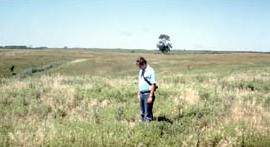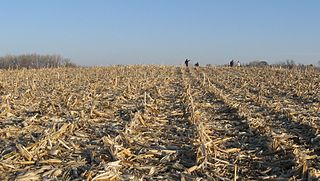
The Hagen Site, also designated by the Smithsonian trinomial 24DW1, is an archaeological site near Glendive in Dawson County, Montana. The site, excavated in the 1930s, is theorized to represent a rare instance of a settlement from early in the period in which the Crow and Hidatsa Native American tribes separated from one another. It was declared a National Historic Landmark in 1964.

The Sunken Village Archeological Site, designated by the Smithsonian trinomial 35MU4, is an archaeological site on Sauvie Island in Multnomah County, Oregon, United States. The site consists of a remarkably well-preserved Chinookan village, dating back more than 700 years. It is a major example of a wet archaeological site, in which cultural materials were preserved in an anaerobic freshwater environment. Finds at the site include well-preserved basketry. The site was declared a National Historic Landmark in 1989.

The Arzberger site, designated by archaeologists with the Smithsonian trinomial 39HU6, is a major archaeological site in Hughes County, near Pierre, South Dakota. It was declared a National Historic Landmark in 1964. It is a large fortified village, that is the type site for the Initial Coalescent, a culture that flourished in the area c. 1200-1350 CE.
The Vanderbilt Archeological Site is an archaeological site located on the shore of Lake Oahe in Campbell County, South Dakota, near Pollock, South Dakota. The site contains the remains of a Native American Plains village which has been tentatively dated to about 1300 AD. Despite the fact that the site is subject to erosive destruction from wave action on the lake, it has been determined likely to yield significant information about the movements and living patterns of prehistoric Native Americans in the region. The site was declared a National Historic Landmark in 1997.

The Bloom Site, designated by the Smithsonian trinomial 39HS1, is an archaeological site in Hanson County, South Dakota. It was declared a National Historic Landmark in 1964.

The Mitchell Site, designated by the Smithsonian trinomial 39DV2, is an important archaeological site in Mitchell, Davison County, South Dakota. It was declared a National Historic Landmark in 1964. At that time it was the only reliably dated site of the Lower James River Phase. The site, sheltered under a dome, is managed by a nonprofit organization and is open to the public as Mitchell Prehistoric Indian Village. Visitors can watch archaeologists uncover artifacts in the Thomsen Center Archeodome. The Boehnen Memorial Museum features a reconstructed lodge and many of the artifacts found at the site.
Arundel Cove Archaeological Site is an archaeological site near Baltimore in Anne Arundel County, Maryland. It is situated on the south shore of Arundel Cove, a tributary of Curtis Creek which drains into the Patapsco River. The site was discovered during routine shovel test pitting of the U.S. Coast Guard Yard at Curtis Bay in 1981. The test pits revealed that the site is small in size, extending only 20 feet north–south by 15 feet east–west. It represents the remains of a prehistoric summer camp which apparently was not repeatedly occupied. It contains a prehistoric period storage pits, with evidence of the use of galium and wild black cherry.

This is a list of the National Register of Historic Places listings in Fall River County, South Dakota.

This is a list of the National Register of Historic Places listings in Harding County, South Dakota.

This is a list of the National Register of Historic Places listings in Corson County, South Dakota.

This is a list of the National Register of Historic Places listings in Davison County, South Dakota.

This is a list of the National Register of Historic Places listings in Hand County, South Dakota.

This is a list of the National Register of Historic Places listings in Hanson County, South Dakota.

This is a list of the National Register of Historic Places listings in Hutchinson County, South Dakota.

This is a list of the National Register of Historic Places listings in Jackson County, South Dakota.

This is a list of the National Register of Historic Places listings in Lyman County, South Dakota.

This is a list of the National Register of Historic Places listings in McPherson County, South Dakota.

This is a list of the National Register of Historic Places listings in Sully County, South Dakota.

The Lynch Quarry site, also known as the Lynch Knife River Flint Quarry, and designated by the Smithsonian trinomial 32DU526, is a historic pre-Columbian flint quarry located near Dunn Center, North Dakota, United States. The site was a major source of flint found at archaeological sites across North America, and it has been estimated that the material was mined there from 11,000 B.C. to A.D. 1600. The site was designated a National Historic Landmark in 2011.

Kimball Village is an archaeological site located in the vicinity of Westfield, Iowa, United States. It is one of six known Big Sioux phase villages from the Middle Missouri tradition that existed between 1100-1250 C.E. The site, located on a terrace overlooking the Big Sioux River, has well-preserved features, including earth lodge and storage pits, and evidence of fortifaction. The site was listed on the National Register of Historic Places in 2010, and as a National Historic Landmark in 2016.


















